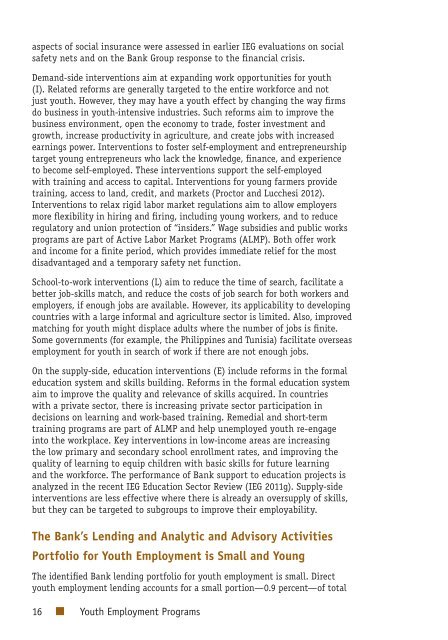Youth Employment Programs - Independent Evaluation Group
Youth Employment Programs - Independent Evaluation Group
Youth Employment Programs - Independent Evaluation Group
Create successful ePaper yourself
Turn your PDF publications into a flip-book with our unique Google optimized e-Paper software.
aspects of social insurance were assessed in earlier IEG evaluations on socialsafety nets and on the Bank <strong>Group</strong> response to the financial crisis.Demand-side interventions aim at expanding work opportunities for youth(I). Related reforms are generally targeted to the entire workforce and notjust youth. However, they may have a youth effect by changing the way firmsdo business in youth-intensive industries. Such reforms aim to improve thebusiness environment, open the economy to trade, foster investment andgrowth, increase productivity in agriculture, and create jobs with increasedearnings power. Interventions to foster self-employment and entrepreneurshiptarget young entrepreneurs who lack the knowledge, finance, and experienceto become self-employed. These interventions support the self-employedwith training and access to capital. Interventions for young farmers providetraining, access to land, credit, and markets (Proctor and Lucchesi 2012).Interventions to relax rigid labor market regulations aim to allow employersmore flexibility in hiring and firing, including young workers, and to reduceregulatory and union protection of “insiders.” Wage subsidies and public worksprograms are part of Active Labor Market <strong>Programs</strong> (ALMP). Both offer workand income for a finite period, which provides immediate relief for the mostdisadvantaged and a temporary safety net function.School-to-work interventions (L) aim to reduce the time of search, facilitate abetter job-skills match, and reduce the costs of job search for both workers andemployers, if enough jobs are available. However, its applicability to developingcountries with a large informal and agriculture sector is limited. Also, improvedmatching for youth might displace adults where the number of jobs is finite.Some governments (for example, the Philippines and Tunisia) facilitate overseasemployment for youth in search of work if there are not enough jobs.On the supply-side, education interventions (E) include reforms in the formaleducation system and skills building. Reforms in the formal education systemaim to improve the quality and relevance of skills acquired. In countrieswith a private sector, there is increasing private sector participation indecisions on learning and work-based training. Remedial and short-termtraining programs are part of ALMP and help unemployed youth re-engageinto the workplace. Key interventions in low-income areas are increasingthe low primary and secondary school enrollment rates, and improving thequality of learning to equip children with basic skills for future learningand the workforce. The performance of Bank support to education projects isanalyzed in the recent IEG Education Sector Review (IEG 2011g). Supply-sideinterventions are less effective where there is already an oversupply of skills,but they can be targeted to subgroups to improve their employability.The Bank’s Lending and Analytic and Advisory ActivitiesPortfolio for <strong>Youth</strong> <strong>Employment</strong> is Small and YoungThe identified Bank lending portfolio for youth employment is small. Directyouth employment lending accounts for a small portion—0.9 percent—of total16 <strong>Youth</strong> <strong>Employment</strong> <strong>Programs</strong>
















